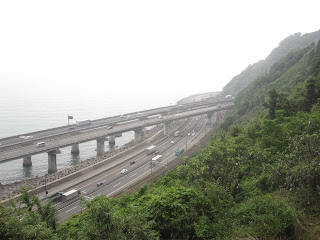I walked from Yui, the 16th shukuba station from Nihonbashi, through Okitsu to Ejiri.
I visited Yui fishing port before starting my walk today. The port is small, but it lands the largest volume of sakura-ebi (small pink shrimp) in Japan.
Hundreds of small fishing boats were tied up in a small space. There was an open-air restaurant where they served sakura-ebi lunch.
The Tokaidi street went into mountainous area. Bothe sides of the road are steep slopes and loquat and orange trees are planted there. Yui’s loquat is nationwide famopus.
Each loquat fruit was covered with a small paper sack. It is to protect the fruit from craw and other birds. Farmers cover the thousands of fruits with the sacks by themselves.
It was the harvest season. I saw many farmers on the trees and took the ripe loquats. They sold the fruits in front of their houses along the street.
I climbed the steep road and arrived at Satta mountain pass. It is 244 meter high.
The pass is known as one of the hardest places (along with Hakone and Oigawa river) to cross in Tokaido in the Edo era.
The view from the pass was beautiful. There spread green trees (loquats and oranges), the blue sea (Suruga Bay) below. Both the national Route 1 and the Tomei Motor highway ran along the seaside.
It was unfortunate that I could not see Mt. Fuji today because of the cloudy weather.
Down the mountain and I moved into Okitsu, the 17th station. There are historic places in the area. They Include:
- Seikenji Temple: Old large temple. Tokugawa Ieyasu often visited here.
- Zagyoso: Saionji Kinmochi, an influencial political leader in the Meiji period had his 2nd house here.
I moved westward and entered Ejiri, the 18th shukuba station. The area is now the center of Shimizu ward of Shizuoka city. Shimizu has a big port. They have developed such industries as fish food production, wharehouse, transportation and marine related machines.






